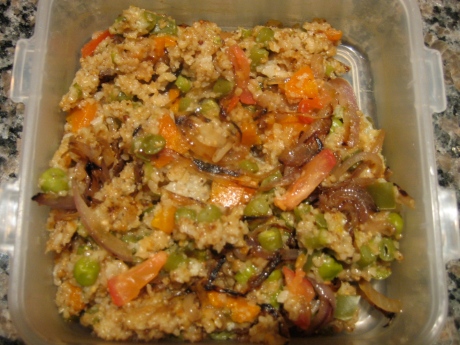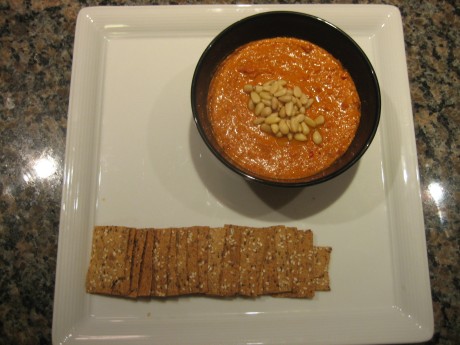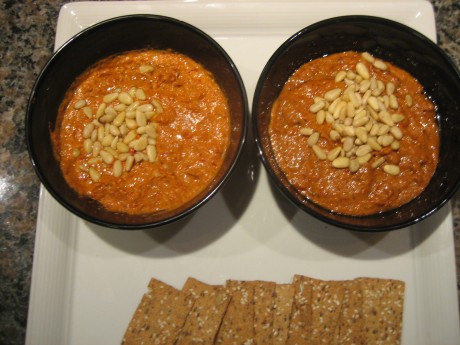Vegetable Daliya
April 10, 2010
I had a rather “delicate” stomach when I was growing up. And every time I was going through one of the bouts of stomach upsets after eating outside food and/or drink, my mother used to feed me plain khichdi (a mush of rice and daal cooked together) or daliya (broken wheat cereal, which she made sweet with milk). So much so that I started to associate these two dishes with being sick. Then one day for breakfast, at my best friends place in Ludhiana, I had a dish which Aunty called daliya, but it was really different from the sweet milky dish I was used to having. This was savory, full of vegetables and rather dry in form. My eyes were opened and I started to have a new respect for wheat as a grain. I now have vegetable daliya as breakfast, but also as a quick, week night meal.
Ingredients
1 cup broken wheat (daliya) – this is different from bulgur in the sense that it is not pre-cooked. It is available in Indian grocery stores.
2 cups water
Oil
1 tsp cumin seeds (jeera)
one small piece ginger
2 green chillies
For vegetables, I use whatever I have at hand. Pretty much anything that softens in one whistle in the pressure cooker is fair game. This time I used the following.
1 carrot
1 small capsicum/green bell pepper
a handful of green beans
a few florets cauliflower
about 1/4 cup peas
Salt and pepper to taste
Optional:
1 small onion
1 small tomato
Method
Grate ginger and mince green chillies.
Chop all the vegetables (except the onion and tomato) to about an even dice. I keep the cauliflower florets a little bigger as otherwise they tend to turn to mush
Dry roast the daliya till it starts to give off the characteristic wheat aroma. Make sure that you stir it intermittently as otherwise the side touching the pan becomes really dark and starts to taste a little burnt. You want the whole thing to evenly turn a shade or two darker.
Meanwhile, in a pressure cooker, heat a little oil. Add the jeera seeds and once they splutter, add grated ginger and minced green chillies.
Once those brown a little bit, add the diced vegetables and stir for a few minutes.
Add the roasted daliya and water and salt. You can also add black pepper if you so wish though I didn’t as I had put enough green chillies for my taste.
Close the pressure cooker and heat till the pressure develops. At this point, reduce the heat to low and cook in pressure for ten minutes.
While this is cooking, you could carmelize some thin sliced onions in very little oil. Make sure you don’t stir the onions too much while caramelizing them so that they brown ‘attractively’. I usually like to add onion and tomatoes on top if I am making the daliya for dinner, to add a rich earthy flavor, but not if it is for breakfast, as then I like the lighter version.
When you open the pressure cooker, gently fluff the daliya and spread the caramelized onions on top.
In the same pan that you caramelized the onions, you may quickly heat some diced tomatoes, not to cook them, but just till they are barely hot and spread them over the daliya as well. If you don’t want to add tomatoes, a squeeze of lemon would be a good addition as well.
Serve hot and enjoy!
Muhammara – an experiment
March 13, 2010
One of my dear friends, who blogs at Baking at Midnight, posted an intriguing recipe a couple of days ago. It was a Turkish dip called the Muhammara. I had never heard about this dip before though I had had many delicious Turkish ‘delights’ at Anjana’s place after they came back from their vacation in Turkey. Somehow the thought of melding the flavors of caramelized onion, sweetness of the red bell pepper and the earthiness of walnuts sounded really appetizing.
When I read through the recipe, it reminded of certain other red pepper dips, usually with garlic, like the one that Emeril makes. Now, I am not usually a big Emeril fan, but I wanted to try the Muhammara with roasting the onion and the red bell pepper instead of sauteing them. I felt that it might enhance the flavors. But, given my rather undeveloped culinary intuition, I was not entirely sure. A scientist by training, what do I do? I plan an experiment. That’s right, a taste experiment.
The Experiment
A friend of mine was coming over to watch a movie at my place last night (though we eventually ended up watching another one after all). I decided to have her and DH be the subjects of my experiment. The idea was that I would make a portion of the dip with exactly Anjana’s recipe, and I would make another portion with everything same except 1) the bell peppers would be broiled and peeled, 2) the onions would be roasted and 3) nothing else would be different. And then we would exactly know the difference that roasting would bring to the recipe. Okay, maybe not exactly, since it is a subjective thing, taste, but still, it would be somewhat precise, maybe. (I am going to have deal with this precision question a lot in the years to come!).
Okay, so anyway, that is the setup. And here are the results.
The Results
The sauteed version got done sooner. Now, sometimes, this can be a win in itself. But that is not what this experiment was about. But the taste was oh-so-delicious! This recipe is a keeper in any case (thanks Anjana!).
And then, presently, the other dip was done as well.
First, the look: the roasted version looked a shade darker than the sauteed one.
Then, the smell: the roasted version smelled the same rich EVOO and red pepper smell as the other one. Wait, was this one a little more smoky?
Participant A: No.
Participant B: Yes.
And finally, and most importantly, the taste:
Participant A (paraphrasing): I liked the sauteed one, as it has more of a lighter, fresher flavor to it.
Participant B (paraphrasing): Definitely, the roasted one. It has a rich, smoky flavor that is way better.
What? So are we even? Well, I know, my bad for setting up the experiment without a large, representative, statistically significant sample. But, we need to have a decision, right? I mean, which one do I make when I have guests over the next time? Okay so I decided to cast a vote as well (this was not the time to be the neutral experimenter).
I tasted one, and then the other. And then I had a little more of the the first one. And then a little more of the second. (Okay, yes, I was hungry). And, I agreed with both of their descriptions. The roasted one did have a deeper, smokier flavor while the sauteed one had brighter notes. My verdict is that the sauteed one would work more for outdoor summer parties (or with the lighter Bollywood fare, like our first movie of the night) and the roasted one would be my dip of choice for late fall evenings (in front of dark brooding movies like our second movie of the evening).
There, go figure! Or have your own taste experiment 🙂


